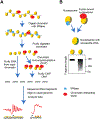Measuring occupancies of the nucleosome and nucleosome-interacting factors in vivo in Saccharomyces cerevisiae genome-wide
- PMID: 37598811
- PMCID: PMC10529416
- DOI: 10.1016/j.ymeth.2023.08.007
Measuring occupancies of the nucleosome and nucleosome-interacting factors in vivo in Saccharomyces cerevisiae genome-wide
Abstract
Nucleosomes are the repeating units of chromatin. The presence of nucleosomes poses a major impediment to all DNA-dependent processes. As a result, access to DNA in chromatin is dynamically regulated by many factors, including ATP-dependent chromatin remodeling complexes. Digestion of chromatin by micrococcal nuclease (MNase) followed by chromatin immunoprecipitation (ChIP) and sequencing can be leveraged to determine nucleosome occupancy, positioning, and the ability of chromatin interacting factors to alter chromatin accessibility. Here we describe the procedure for performing MNase and MNase ChIP-seq in detail.
Copyright © 2023 Elsevier Inc. All rights reserved.
Conflict of interest statement
Declaration of Competing Interest The authors declare that they have no known competing financial interests or personal relationships that could have appeared to influence the work reported in this paper.
Figures


References
-
- Kornberg RD (1974) Chromatin Structure: A Repeating Unit of Histones and DNA: Chromatin structure is based on a repeating unit of eight histone molecules and about 200 DNA base pairs. Science, 184, 868–871. - PubMed
-
- Li B, Carey M and Workman JL (2007) The role of chromatin during transcription. Cell, 128, 707–719. - PubMed
-
- Han M and Grunstein M (1988) Nucleosome loss activates yeast downstream promoters in vivo. Cell, 55, 1137–1145. - PubMed
-
- Venkatesh S and Workman JL (2015) Histone exchange, chromatin structure and the regulation of transcription. Nat Rev Mol Cell Biol, 16, 178–189. - PubMed
-
- Yuan G-C, Liu Y-J, Dion MF, Slack MD, Wu LF, Altschuler SJ and Rando OJ (2005) Genome-scale identification of nucleosome positions in S. cerevisiae. Science, 309, 626–630. - PubMed
Publication types
MeSH terms
Substances
Grants and funding
LinkOut - more resources
Full Text Sources
Molecular Biology Databases
Research Materials

